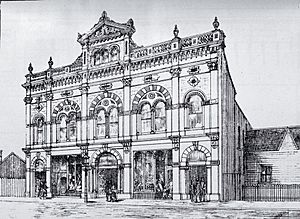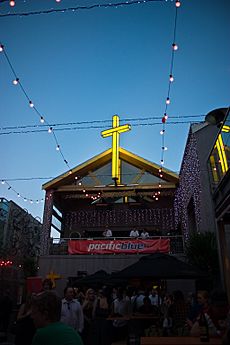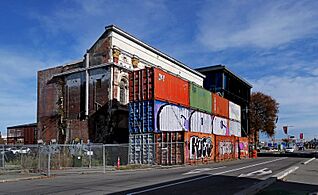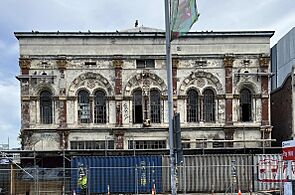Odeon Theatre, Christchurch facts for kids
Quick facts for kids Odeon Theatre |
|
|---|---|
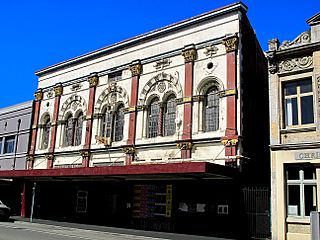
The Odeon Theatre in Tuam Street, Christchurch (October 2010)
|
|
| Former names |
|
| General information | |
| Type | Former theatre |
| Architectural style | Italianate architecture with Venetian Gothic elements |
| Location | Christchurch Central City |
| Address | 214 Tuam Street |
| Town or city | Christchurch |
| Country | New Zealand |
| Coordinates | 43°32′8″S 172°38′21″E / 43.53556°S 172.63917°E |
| Completed | 1883 |
| Inaugurated | 20 July 1883 |
| Renovated | 1927 |
| Demolished | September 2012 |
| Technical details | |
| Structural system | Unreinforced masonry |
| Floor count | two |
| Design and construction | |
| Architect | Thomas Stoddart Lambert |
| Renovating team | |
| Architect | Sidney Luttrell |
| Designated: | 26 November 1981 |
| Reference #: | 3140 |
The Odeon Theatre in Christchurch, New Zealand, was a very old and important building. It was the oldest theatre in New Zealand built with bricks and stone. It was also one of only three theatres from the 1800s still standing in the country. Over the years, this building had many different names and was used for many things.
Sadly, the Odeon Theatre was badly damaged in the 2011 Christchurch earthquake on February 22, 2011. It was so damaged that it could not be fixed. Parts of it were taken down in September 2012. The theatre was special because it was a "Category I heritage building." This means it was very important to New Zealand's history. A famous person named Kate Sheppard used the theatre for her campaign to help women get the right to vote.
Contents
History of the Odeon Theatre
Building the Theatre
A group of people formed a company to build the theatre. It was built in 1883 at 214 Tuam Street. The design was created by an architect named Thomas Stoddart Lambert. The theatre was very large and could hold 2,200 people. About 600 of these people could sit in the upper balcony, called the gallery. The stage was also very big. The theatre first opened on July 20, 1883. The Mayor of Christchurch, George Ruddenklau, was there for the opening.
Many Uses and Names
The building was first called the Tuam Street Hall or Tuam Street Theatre. It was used for many different things. People held public meetings there, watched entertainment, saw exhibitions, and even roller-skated!
In 1893, Kate Sheppard used the hall for her important work. She was campaigning for women to have the right to vote. New Zealand was the first country in the world to let women vote. This happened when the Electoral Act was passed on September 19, 1893. Just a week later, on September 26, Kate Sheppard held a meeting at Tuam Street Hall. About 600 women signed up to vote that day, even though the weather was bad.
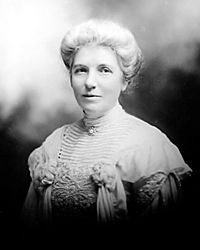
In 1894, the theatre's name changed to the Opera House. At this time, a type of entertainment called Vaudeville was very popular. A theatre company run by John Fuller's son, Benjamin, started using the building in 1903.
Changes and Famous Performers
The inside of the building was changed in 1927 by architect Sidney Luttrell. It reopened on December 26, 1927, and could then seat 1,300 people. The stage was made even bigger, and there were 19 dressing rooms.
In 1930, movies became popular, so the theatre's name changed again to St James. Even though it showed films, the stage was still there. Sometimes, live shows were still performed. The St James theatre closed for a while during the Great Depression, a time when many people had little money. In the 1940s, many famous performers appeared there. These included the Trapp Family Singers, Stanley Holloway, Johnny Devlin, Laurence Olivier, and his wife Vivien Leigh.
In 1960, the building was bought by a company called Kerridge-Odeon Ltd. It was renamed Odeon and reopened on September 27, 1960. More changes were made, like removing a decorative wall on the roof. The number of seats was reduced to 720, and new movie equipment was added. There was even a coffee lounge. Over time, fewer people came to the theatre because television became popular. The theatre eventually closed.
In 1983, a church group called the Sydenham Assembly of God bought the building. They used it for religious meetings starting in 1985.
Later Years and Efforts to Save It
In 2003, some business people bought the building. They wanted to tear it down. Because of this, a group of people who wanted to save the building formed the Odeon Theatre Trust. The building was sold again in December 2006 to a company owned by David Henderson.
When the Sydenham Assembly of God owned the theatre, they put a large, glowing yellow cross on the front. Later, David Henderson used this cross in a new area he developed called SOL Square. He even named one of the bars there the Yellow Cross.
In 2009, a Christchurch actor named Mark Hadlow wanted the Odeon Theatre to become a big arts center. He thought it would cost about NZ$60 million.
Heritage Status
On November 26, 1981, the New Zealand Historic Places Trust (now called Heritage New Zealand) officially listed the Odeon Theatre as a Category I historic place. Its special number was 3140. This listing meant the building was very important for its history and culture.
The Odeon Theatre was recognized for several reasons:
- It was once the biggest public meeting place in Christchurch.
- It was the oldest theatre still standing in Christchurch.
- It was the oldest theatre in the country built with bricks and stone.
- Its use by Kate Sheppard for women's suffrage was very important.
- It was connected to two important Christchurch designers, Thomas Lambert and Sidney Luttrell.
Being a Category I place means it has "special or outstanding historical or cultural heritage significance or value."
Earthquake Damage and Future
The Odeon Theatre was severely damaged in the 2011 Christchurch earthquake in February 2011. The government agency in charge of earthquake recovery ordered the building to be torn down in January 2012. Most of it was demolished later that year.
Because of its heritage status, the front part of the building (the facade) and the entrance areas (foyers) were saved. The main part of the theatre, including the seating and stage area, was removed. Large shipping containers were placed in front of the building on Tuam Street to protect the remaining facade. For many years, the Odeon was on the City Council's list of damaged buildings waiting to be dealt with.
In August 2020, the local government group Environment Canterbury (ECan) bought the Odeon Theatre and the building next to it. They paid $2.95 million for them. ECan also bought an empty piece of land nearby. The goal was to make ECan's office area more organized and to create a space for environmental groups.
In March 2022, ECan started looking for partners to help restore the theatre. They tried to find private companies to develop and lease the property in 2023, but they were not successful. The shipping containers in front of the Odeon were removed in January 2024 by order of the City Council. ECan then had to spend $1.2 million to make the facade stable and safe, even though they were not restoring it.
In June 2025, ECan decided to sell the Odeon Theatre and the empty land next to it. Keeping the property was costing them a lot of money each year for maintenance, taxes, and loan interest. These costs were not planned for, and the property had cost ECan $8 million in total. Developers were invited to buy the land. It is unlikely that anyone who buys the Odeon's facade will be allowed to tear it down because of its important heritage status.


